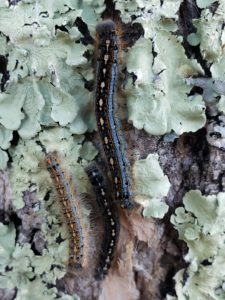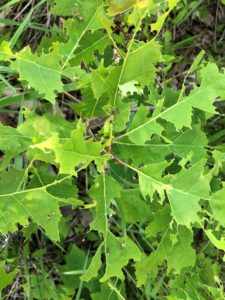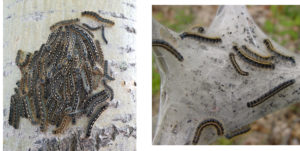Linda Williams, forest health specialist, Woodruff, Linda.Williams@wisconsin.gov, 920-360-0665
Forest tent caterpillar (FTC) is a native insect with periodic outbreaks. Reports of high populations have been coming in this spring from the towns of Nokomis, Three Lakes and Sugar Camp in Oneida County. There is some defoliation in these areas, but the geographic extent of damage is still limited. When looking for caterpillars in northeastern Wisconsin, it was not difficult to find at least one or two of them, which is an increase from past years when it was difficult to find any caterpillars at all.

Forest tent caterpillars go through several instars, or growth stages. Colors vary between stages but all have the cream-colored “boot prints” down their backs.
Forest tent caterpillar outbreaks typically occur every 12-15 years and last about three years per outbreak. The last one in northern Wisconsin occurred from 1999-2002. Many Northwoods residents remember that time because there were vast swaths of defoliated forest, and caterpillars were found in huge numbers. Some residents may remember the “friendly flies,” a fly species that parasitizes FTC cocoons. To some, these large bumbling flies were found to be just as irritating, or more so, than the caterpillars themselves.

Forest tent caterpillar defoliation on a young oak tree.
Don’t mistake forest tent caterpillar with eastern tent caterpillar. Eastern tent caterpillar makes webbed nests in trees in the spring. They often feed on wild black cherry trees growing along roadsides, but they also like to feed on crabapple and apple. By contrast, forest tent caterpillars prefer to feed on aspen, oak and even ash, among several other tree species. UW-Madison Extension has a webpage comparing look-alikes to help you distinguish between several species of caterpillars.

Forest tent caterpillars (left) do not build webbed nests but congregate in large groups on trees or other vertical objects. Eastern tent caterpillars (right) do create webs. The two can also be distinguished by yellow markings on their backs, which are shaped like boot prints on FTR and like a solid line on eastern tent caterpillar.
Please report any suspected FTC defoliation to your local DNR forest health specialist, and visit the DNR FTC webpage for more info.
